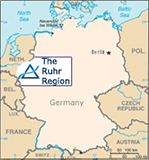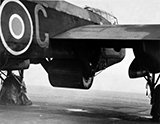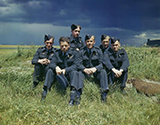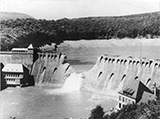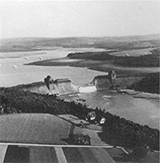
Over the years, many Star Wars fans have written or read about the cinetmatic similarities between the 1955 World War II film, The Dam Busters and the Death Star trench battle from A New Hope. If you watch the clip below from The Dam Busters, you'll most certainly notice that George Lucas, in many ways, visually copied the dam attacks as presented in the film. In some scenes it is obvious he even used the same dialogue. If you're interested in learning more about the cinematic similarities, read our fellow Rogue, Bryan Young's blog on the subject from December, 2013. This article, however, will take a different route by not discussing the similarities between the two films. Instead, we will examine the similarities between the true story of the Dam Busters and the Rebels' attack on the first Death Star.
Britain's Operation Chastise was one of the most daring missions of World War II. Bomber crews risked it all to destroy Hitler's dams along Germany's Ruhr Valley. Their success, loss and bravery would become legend, inspiring one of the greatest space battles in film history, the attack on the Death Star.
In warfare, one generally thinks of war as being limited to the soldiers fighting on a battlefield, but total war brings the conflict into the towns and homes of the civilian population. World War II is by far the largest total war ever waged. Millions of civilians, thousands of industries, and hundreds of cities were directly impacted by the events of the war. A total war is defined as the complete mobilization of all available resources. This essentially means that an entire country’s population and industrial capabilities are involved in the war in some way. Civilians can be involved through rationing food and industrial materials like rubber, metals, fuels, etc. or they can work in the countless war industries in an effort to aid in earning victory. A belligerent can also target enemy civilians in an effort to demoralize them and earn their surrender. This was Hitler’s strategy in Britain. Both sides, Allies and Axis, engaged in total war throughout World War II. Entire industries shifted from making consumer goods like cars to manufacturing military hardware such as tanks and airplanes.
What makes a country engage in total war? One may seek to demoralize an enemy's civilian population as Hitler attempted to do in Britain. It may also benefit business owners to support the war by earning military contracts or expanding globally. For example, Coca-Cola worked to supply Allied soldiers with Coke throughout the war. This had a huge financial impact on their company both during and after the war. However, there is a more strategical use of total war. Imagine if Britain could stop the Luftwaffe (German air force) attacks not by simply defending their own air space, but rather by sending their bombers into Germany to destroy the very factories that manufacture the Luftwaffe’s airplanes.
In Star Wars: A New Hope, we see the Empire engaging in total war through their unjust destruction of Alderaan and its civilians. Despite Princess Leia’s plea and reminder that the people of Alderaan were peaceful, Grand Moff Tarkin gave the go ahead to destroy the planet using their latest weapon, a mobile moon-sized battlestation, the Death Star. Tarkin explained the true purpose of the Death Star when he stated, "Fear will keep the local systems in line. Fear of this battle station." For the Rebels, their mission was now clearer than ever, destroy the Death Star or be destroyed themselves.
The Ruhr River Valley is a river system found in Western Germany and was a heavily industrialized area before and during WWII. Numerous German factories lined the areas around the river, utilizing it for cheap and easy transportation of industrial materials. Another, more obvious, use of the river was its supply of drinking water for nearby towns. Perhaps the most important use of the river was the numerous dams built to provide hydroelectric power to the factories and towns along the Ruhr.
During World War II, the British Air Ministry recognized the Ruhr Valley as being of significant strategical importance. It was known that many weapons and Luftwaffe aircraft were produced in the factories of the Ruhr. Rather than bomb the factories directly, plans were devised to target the dams providing precious power and water to factories. British engineers knew it would take months to repair or rebuild the dams, thus greatly crippling the Nazi’s ability to wage war. The dam attacks would be a strike at the heart of German military strength. Operation Chastise had begun.
In Star Wars, Rebel leaders understood that elimination of the Death Star would significantly weaken the Empire, possibly allowing the Rebels to gain a much needed upper hand. It is worth noting that the destruction of the Death Star would do more than eliminate the battle station itself. Thousands, if not millions of Imperial forces were on the Death Star along with thousands of TIE fighters/bombers and countless other resources needed for waging war against the Rebellion. Faced with incredible odds and no other choice, the Rebels moved forward with their suicidal plan to attack the Death Star.
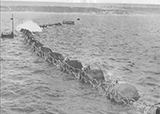
A typical WWII torpedo net. The majority of it descends deep below the surface of the water to protect ships, or in this case, dams.
Attacking and blowing up a huge dam sounds easy enough, but the Germans had a tremendous amount of foresight and recognized that their dams would be obvious targets. As such, great measures were taken to protect the dams from air attack. Each dam was surrounded by anti-aircraft guns that were consistently manned throughout the early years of the war. To further prevent air attacks, several torpedo nets were placed in front of each dam to stop any torpedoes from reaching the dam face. The only exception to this was the Eder Dam which was surrounded by hills that the Germans believed would protect it from attack. No torpedo nets or anti-aircraft guns were installed at the Eder Dam, which was guarded by two German soldiers with rifles.
In order to do serious damage to the dams, both sides knew that a torpedo or self-propelled underwater bomb attack would be required. If bombs were simply dropped on the surface of each dam there would be no guarantee that the damage would be enough to actually breach the dam. At this time, the Allies simply did not possess a bomb strong enough to cause the type of damage they needed from above the water’s surface. The German’s use of torpedo netting and anti-aircraft guns made successful attacks on the dams practically impossible.
Thanks to Rebel spies and Princess Leia, the Death Star’s plans had been captured and preserved by R2-D2. After reviewing the plans, General Dodonna revealed his risky plan of attack. A Rebel attack squadron consisting of X-wings, A-wings, and Y-wings would approach and engage the Death Star. Their target was a heavily defended trench system that terminated with a one meter wide exhaust port where a well-placed proton torpedo could reach the Death Star’s main reactor, causing a chain reaction that would destroy the battle station. Similar to the dam busters, a mere surface attack would do little to destroy the Death Star, thus a riskier plan was required.
Despite the impossibilities, the British persisted in devising a way to take out the dams from the air. A British engineer named Barnes Wallis had already designed several bombs for the Allies and was presently working on what would become the “earthquake bomb” when he was asked to devise a solution for attacking the dams. Wallis was a visionary and understood the need to focus on German power sources rather than factories alone. He once said, “If their [power plants] destruction or paralysis can be accomplished they offer a means of rendering the enemy utterly incapable of continuing to prosecute the war".
Wallis’ main task was overcoming the challenge of the torpedo netting that protected each dam. In 1942, Wallis had a revelation while skipping stones in water tanks found in his garden. He conceived of a bomb that could be dropped from an aircraft and skip along the surface of the water, bouncing over the protective torpedo netting to reach the dam, sink, and then explode. The concept of the “bouncing bomb” was easy enough, but now Wallis had to invent a way to make a bomb skip on the surface of the water.
After months of experimentation, Wallis settled on a drum shaped design for his “bouncing” or upkeep bomb. The design is similar in look to a depth charge. It was discovered that the bomb had to be spinning when released to create the bounce needed and to also ensure it traveled the necessary distance to the dam. A clever mechanism was constructed to spin the bomb up to 500 rpm prior to release. This mechanism was mounted beneath heavily modified Avro Lancaster bombers. One concern was that the bomb may strike the dam and, still spinning, spin itself away from the dam before detonating. To counter this possibility, the bomb would be spun backwards. Now, when the bomb struck the dam, its backwards spin would continue to force it towards the dam as it sank.
Initial testing in Britain revealed some additional challenges. First, to protect the bomber crew, the attacks would occur at night. Second, the bomb had to be dropped at no higher than 60ft from the water’s surface, dangerously low for a heavy bomber. Thirdly, the bomber would be travelling in excess of 240mph so that it could pull up before striking the dam itself. Fourth, to carry the heavy bomb and ensure the plane could pull away from the dam in time, much of the bomber’s armor was removed making the aircraft more susceptible to being shot down during the attack run. As a final complication, the upkeep bomb had to be dropped at precisely the right altitude, speed, and distance from the dam. Because the missions would occur at night, the pilot relied on two spotlights attached to the underside of the plane. The spotlights were ingeniously aligned so that, at the correct altitude, the two lights would converge on each other letting the pilot know the correct altitude had been reached. In a time before GPS, laser guidance, and night vision it seemed Operation Chastise was anything but possible.
Similar to the dam busters, the rebels in Star Wars were required to fly within a narrow trench at extreme speeds while also avoiding turret gunfire. Appropriate timing and distance for releasing the proton torpedo was also paramount. In Star Wars, the targeting computers and their slowly converging lines that represented the craft’s distance to target were likely inspired by the dam busters’ use of spotlights to monitor their height.
Another similarity involves Luke having to greatly increase the speed of his X-wing during his trench run. Like the dam busters, Luke was travelling at such a high rate of speed it was possible that he would impact the end of the trench shortly after firing his proton torpedo. In fact, Luke was going so fast, his friend Biggs Darklighter was concerned enough to shout, "Luke, at that speed will you be able to pull out in time?" The dam busters faced a similar challenge in their attack runs on the dams and, unlike Luke, not all of the bombers made it out unscathed.
The challenges of Operation Chastise not only required specially designed weapons and tactics, but also the best bomber crews in Britain. Nineteen bomber crews were assembled and trained for the daring dam attacks. A total of 153 crew members made up the men we now remember as the “dam busters.” The crews were primarily British, but Canadians, Australians, and New Zealanders also aided in the attacks.
The primary targets were the Mohne and Sorpe dams with the Eder Dam serving as a secondary target. The nineteen bombers launched in three waves or groups on the night and early morning hours of May 16-17, 1943. Two flight routes were used to avoid known German anti-aircraft locations once they reached mainland Europe. Despite these precautions, several of the aircraft encountered resistance from the ground and eight of them were shot down before, during and after their attacks on the dams.
Travelling in groups was important as it would increase the likelihood of breaching the dams. If one crew missed or managed only minor damage, there would be another bomber ready to take their turn on the dam. Despite this plan, some of the crews dangerously made multiple runs on their dams due to misalignments, altitude, speed factors, etc. One crew made nine attempts on the Sorpe Dam before dropping their bomb on the tenth run, only managing to damage it.
The Mohne Dam, was finally breached after multiple bombers dropped their bombs and struck the dam. A similar result came out of the Eder Dam which was also destroyed after several runs and bombs. The other dams attacked that night, the Sorpe and Ennepe, were damaged but not breached. At least two other dams were intended to be secondary targets that night, but were not attacked.
Only eleven of the nineteen bombers returned to England on the morning of May 17. Eight aircraft were downed and fifty three airmen were killed in the daring attacks, a casualty rate of nearly 40%.
The attack on the Death Star proved as dangerous and costly as expected for the Rebels' Red Squadron. Out of thirty spacecraft only two X-wings and a Y-wing returned from the battle. Still, attacking the Death Star in groups and being prepared for more than one attack run enabled the Rebels to ultimately destroy the station. Much like the dam busters, the cost had been great, but the mission had proven successful thanks to careful planning. For the Rebels, the destruction of the Death Star did not guarantee a final victory, but it did stop their certain annihilation and enabled them to continue the fight against the Empire.
Despite the tremendous losses, two dams were breached and two others were significantly damaged. Did the attacks have the long-term, anticipated results on the Germans ability to wage war that the Allies had hoped for? Historians often disagree on just how much the destruction of the dams hurt Germany, but most agree that the German military might was at least hampered by the dam busters.
Destruction of the Mohne resulted in: a few mines were flooded; 11 small factories and 92 houses were destroyed and 114 factories and 971 houses were damaged. The floods washed away about 25 roads, railways and bridges as the flood waters spread for around 50 miles (80 km) from the source. Estimates show that before 15 May 1943 water production on the Ruhr was 1 million tonnes, this dropped to a quarter of that level after the raid.
Through auxiliary means, most areas had water and power restored within two months of the attack and the attacks only proved to be a minor inconvenience. Perhaps most puzzling of all was the lack of further attacks on the dams. Had the British sent more bombers in the following days they likely could have destroyed the dams beyond repair. The most significant damage caused by breaching the dams was the destruction of vast amounts of farmland that stifled food production in the region for the next decade. Although the attacks did not create a permanent or long-term setback to the German ability to wage war, the story of the daring Dam Busters acted as a much needed morale boost in Britain.
The greatest impacts of the dam busting raids were that repair efforts pulled laborers away from construction of the Atlantic Wall, which was Hitler’s fortification being built along Northern Europe to prevent invasion. Weaknesses in the Atlantic Wall would prove invaluable on D-Day. Barnes Wallis’ success with the “bouncing” bomb enabled him to produce his earthquake bombs (Tallboy and Grand Slam) which proved useful to the Allies later in the war.
Luke Skywalker, Death Star, X-wing Fighter, TIE Fighter, Rebel Alliance, Galactic Empire
- Imperial War Museum - Operation Chastise
- UK National Archives: The Dam Busters Exhibition
- BBC- The Dambusters
- TheDamBusters.org
- Dam Busters Infographic Poster
First posted on: April 14, 2014 by Wes Dodgens


